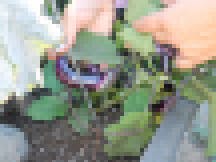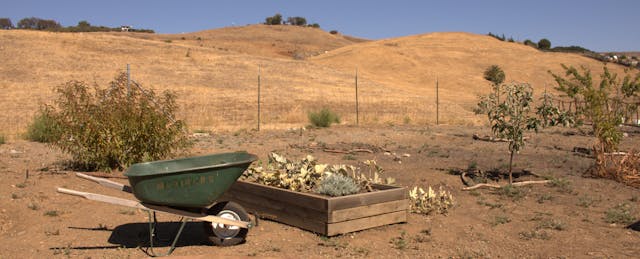HAYWARD, Calif. — Language teacher Serena Maniscalco never thought a composting initiative she led several years ago would lead to the development of an learning space that would help so many students grow. But it spurred the development of a garden at Moreau Catholic High School, a private school where students get to grow produce like pumpkins, tomatoes, eggplants and lemons.
Moreau students are learning through experience about how things grow, where food comes from and why nutrition matters. However, the benefits of the garden go beyond developing contextual understanding around environmental sustainability—students are using the space for unintended reasons—and it’s yielding unexpected results.
A Seed Sprouts
Situated under rolling hills, the garden that exists today grew out of a composting initiative that Maniscalco was getting off the ground in 2011. She was able to get the school to start composting with the city, but the students didn’t understand the purpose behind it. They had studied food deserts and were interested in learning more; Maniscalco wanted to tap into their curiosity.
A green thumb ran in Maniscalco’s family. She grew up gardening with her grandmother and started a gardening program at the charter school in San Lorenzo where she taught before joining the team at Moreau. She knew that creating a garden could help students build a deeper understanding around composting.
Coincidentally, the school was working on building a new track field in 2015, and clearing out a construction zone in the back area. She asked the head of maintenance if the space was being used and he said, “We could move all that stuff and make that a garden,” so that’s what they did.

The garden, and all the work that goes into it, isn’t technically part of Maniscalco’s language curriculum or job description, but she has found the time to work it into her schedule. She thinks there’s a connection to the environment that people often ignore, and because she’s not a science teacher, she has to “sneak it” into her curriculum. Maniscalco contends that students haven’t used composting in the garden much, because right now, they’re more focused on expanding the garden. But, they’ve used it to grow in other ways.
Direct Exposure
Maniscalco uses the garden to support her language classes in a number of ways. She encourages teamwork by having each table in her Spanish class plant a seed. Every day, a different person from the table has to water it in class and by the end of the quarter, if the seed has grown enough to plant it in the garden, the students get an incentive toward their grades. She also has students talk to their plants in Spanish, without fear of the plant judging their language skills. She says some of them really get into it, though others think the idea is ridiculous. And if she teaches a unit on, say, Dolores Huerta or Cesar Chavez, she’ll take her class out to work in the garden for a change of scenery.

Earthwise, the student environmental club, formally meets twice a week. On Mondays, any student can come to work in the garden. On Wednesdays, officers of the club plan how to sustain and expand the garden. Simrithi “Simi” Sethupathi, a senior and the co-president of Earthwise, finds it fulfilling to see where the garden can go, and to educate the school community about how to be more green.
Maniscalco notes that students are also getting exposed to the garden across a variety of content areas. For example, in their English class, some students use the garden while exploring transcendentalism with Emerson and Thoreau, and in an art class, they use watercolors to create landscape paintings. The theology teacher takes students to the garden too. Although not every student is religious, those who are have been more aware of where their food comes from and when giving thanks for their food, consider the farmer.
Maniscalco has also seen more students show interest in AP environmental science, and notes an increase in seniors centering their mandatory capstone projects around the environment.
Over time the garden has come to serve an even wider population. It has become a space that helps kids learn about the environment, connect to the outdoors, unplug and find space to think—and students are making use of the garden in different ways.
Unexpected Impact
The garden is supportive of mindfulness, which is a school-wide initiative at Moreau. It’s a relatively tech-free area where kids can go to work through their emotions, unwind, regain their attention or even cool off if a behavioral situation escalates.

Maniscalco says that during class at the 1:1 device school, teachers might think students are listening, but often “they’re writing emails with their friends or chatting.” She adds that in her two decades of teaching, she’s seen more kids struggle with anxiety and their emotions. “They're so bombarded with technology that they feel uncomfortable in silence,” says Maniscalco. “I think the mindfulness thing isn't just for kids that struggle academically. I think every kid needs it.”
Parents are noticing the benefits too. She recalls the parent of a child diagnosed with obsessive-compulsive disorder thanking her for letting him pick weeds in the garden, explaining that he finds the action calming, and thinks it helps him stay focused. Now, when he experiences frustration, Maniscalco is able to send him to the garden to pick weeds
Maniscalco says that kids also come on their own time since the garden isn’t closed off, and that some students are seeking out other ways to expand their learning. Some are able to make the connection that gardens like the one they have at their school are where their food comes from. She also notes that some students go on alternative spring breaks, for example, to volunteer on a farm in the Watsonville, Calif. area. There has even been interest forming a hiking club.

For Maniscalco, the garden as provided a way she can connect with kids who don’t identify as “super academic” or “super athletic,” but have “this other sense of learning.”
Growing the Garden
When Maniscalco first started, she wanted to “guerilla garden,” but the school wanted her to slow down. They had to write out a three-year plan for the garden and, along with some students, present it to some members of the school board. It’s about time for her to submit another three-year plan. She says every year, things get more institutionalized.
Now entering its fourth year, the garden has survived three principals. “We started from nothing,” Maniscalco says. But they’ve come a long way, and Maniscalco and the kids want to keep growing the garden.

By the end of the year, they hope to add an outdoor classroom and meditation space, complete with seating and a router that teachers can turn off and on as they instruct. And by Fall 2019, they hope to have an outdoor oven installed in it, so students can cook what they grow.
“Every year there are more and more people,” Maniscalco says. “We get bigger and bigger. I mean, physically we get bigger and bigger.” The best part for her? “Seeing them come out here and really step away from technology and be in the moment.”


